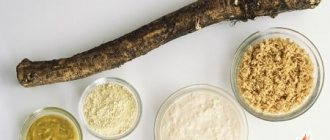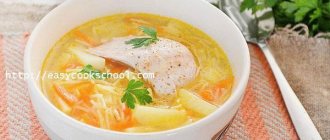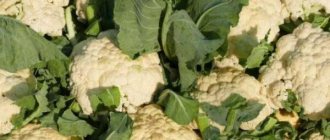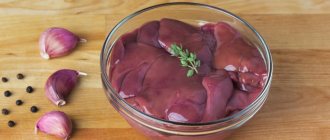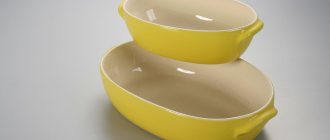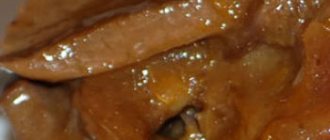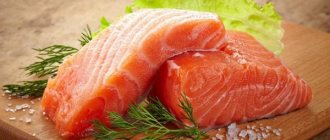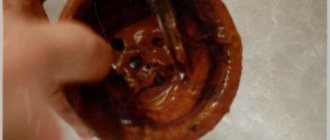Preparing the product for cleaning
Before you begin peeling the root, the horseradish should be washed off the soil. To make this task easier, the rhizomes are soaked in cold water for 4–5 hours and then washed. In places where dirt adheres especially firmly (nodules, branching roots), the roots can be rubbed with a stiff brush. The clean, water-soaked outer part of the plant is much easier to remove. Young, freshly dug thin roots intended for chopping do not need to be peeled, since their peel is very thin and can be easily ground in a meat grinder or blender.
Soaking in water helps loosen the dirt on the root and makes it easier to prepare for cleaning.
It is highly not recommended to try to cut the skin from the roots along with the soil, as dirt and bacteria can get directly onto the clean part of the vegetable.
Important! Peeling the horseradish root and further grinding it should be done while wearing gloves. The active substances of the plant can cause irritation, allergic reactions and skin burns.
Gloves will protect the skin of your hands from irritation, burns and contamination.
Another way to simplify cleaning is to freeze the roots. To do this, the required amount of plants is placed in a plastic bag, tied tightly and left in the freezer for 1.5–2 hours. Horseradish also needs to be washed and dried before freezing.
Horseradish roots must be clean and dry for freezing.
How to wash your hands after processing horseradish
Having cleaned the roots, we are faced with another problem - dirty hands. It's quite easy to deal with:
- Cut 2 slices of lemon.
Lemon is a proven remedy for removing dirt from under nails and cleansing the skin of hands.
After treating with lemon juice and pulp, you should wash your hands with warm soapy water.
Video: how to clean soil-stained hands
To prepare any dish, it is not enough to choose the ingredients; you need to wash and clean them properly. Especially when it comes to vegetable preparations. The tips described above will help you quickly and easily remove the skin from horseradish.
Methods for cleaning horseradish
After the preparatory stage, you can begin peeling the roots. The most commonly used tools for this are:
- knife;
- vegetable peeler;
- metal grater;
- metal scourer for washing dishes.
Let's look at each option in more detail.
Cleaning roots with a knife
For this method of cleaning horseradish roots, you need a well-sharpened knife that fits comfortably in your hand.
A sharp, convenient knife ensures quick peeling of horseradish roots
Step-by-step instruction:
- Blot the peeled horseradish root with a kitchen towel or paper napkins.
- Cut off the knots and tendrils. If the root has several branches, divide it into parts.
- Holding the root firmly in your left hand (for left-handers, in your right), cut off long strips of skin, working with the knife from top to bottom. Turn the spine in a circle until all sides are peeled.
The sharper the knife, the thinner and easier the strips of skin can be removed. - Cut off the root tip.
- Repeat with all other roots.
Advice. To prevent the peeled roots from darkening in the air, place them in a bowl of cold water.
Cold water will protect the peeled roots from darkening.
The disadvantage of this method is that part of the root itself is cut off along with the skin. But due to the speed of the process, this option is the most popular among lovers of homemade horseradish.
Peeler for horseradish
The use of a special device for peeling vegetables greatly simplifies the work of housewives. Affordable price and ease of use have made a vegetable peeler an integral attribute of every kitchen, which can also be used to peel horseradish roots.
A vegetable peeler is an excellent assistant in peeling horseradish roots.
Step-by-step instruction:
- Wash the root, dry with napkins or a towel.
- Hold the root over the sink or large bowl and carefully remove strips of skin with a vegetable peeler.
Peeling allows you to remove a very thin layer of skin, preserving more vitamins and minerals - Cut off the root tip.
- Repeat until all plants have been cleaned.
This cleaning method allows you to cut off a thinner layer of peel than when working with a knife. Thanks to this, the product retains more nutrients. The undoubted advantages of such a device are the safety of its use and maintaining cleanliness and order in the kitchen, since cleaning products do not scatter everywhere.
Using a metal grater
This method can only be used to clean young roots with skin that has not yet hardened. As in the options described above, the roots need to be washed and dried, and then the top layer should be removed by lightly rubbing the surface of the root with a metal grater with fine holes. The downside is that part of the vegetable itself will be removed along with the skin. Therefore, movements should be light, smooth and without strong pressure. After removing the peel, you should rinse the grater, wash and dry the root, and then continue to chop the white part of the vegetable, turning it into small chips.
Using a fine metal grater, you can remove the skin and chop it for further use as food.
Metal sponge for cleaning horseradish
A special metal sponge, which is used for washing very dirty dishes, can also help in cleaning horseradish roots. Such a sponge will not cope with rough skin, but it will easily clean the roots of dirt and remove the skin of young plants. Kitchen sponges tend to accumulate a huge amount of harmful bacteria, so it is recommended to use a new mesh to clean the horseradish. If this is not possible, then a previously used sponge should be washed thoroughly in hot water with the addition of baking soda, and then doused with boiling water.
A hard dish sponge does an excellent job of removing dirt and peels from horseradish roots.
High pressure washer
An unusual and quite interesting way to clean young horseradish roots is to use a Karcher mini-wash. The roots are placed in a metal or plastic mesh with small cells and cleaned using a stream of water supplied from a high-pressure device.
Video: a quick way to peel horseradish
Do I need to peel horseradish root?
Horseradish contains a valuable set of vitamins and minerals, is used for inflammation of the joints, urolithiasis, in cosmetology to remove age spots, freckles and tan marks, and also stimulates appetite and helps improve digestion.
Due to its healing properties, horseradish was highly valued in Rus'. Peter I even issued a decree according to which every house had to have several bottles of bad vodka.
Both the leaves and rhizomes of the plant are eaten. But if the former find their use mainly only in preservation, then the latter are also the basis for unique sauces for meat, fish and jellied dishes. In this case, the skin is cut off, as it is too tough. The only exceptions are thin young roots - the peel on them is still quite soft, and it is not necessary to remove it.
Horseradish seasoning has only one parameter that is significantly inferior to mayonnaise, mustard or ketchup - limited shelf life, which is only 14–15 hours.
Horseradish-based seasonings are an integral part of Russian cuisine
How to avoid tears
The essential oil contained in horseradish roots can cause severe irritation to the mucous membranes of the eyes, nose and throat. To avoid tears, runny nose and sneezing, sore throat and cough, you should listen to the following tips:
- freeze the vegetable for 5 to 6 hours before peeling and chopping (this will not only help avoid tears, but also make it easier to prepare);
- clean horseradish roots in the fresh air: in a country house, an open balcony or an unglazed loggia (in an open space, the concentration of substances irritating the mucous membranes is minimal);
- When working indoors, open windows and/or turn on the hood;
- use a thick gauze bandage covering the mouth and nose (it will prevent the penetration of essential oil molecules into the respiratory tract);
- Protect your eyes with diving goggles.
Swimming goggles will help you not shed a tear.
What you need for cleaning: tools and conditions
For work you will need:
vegetable peelers (there are horizontal and vertical, they help to easily and economically peel even thin roots);
Instead of a brush, you can use a special glove for cleaning young potatoes, which appeared on the market relatively recently. It will help remove impurities from horseradish. One side of the glove is quite tough. All you need to do is rub the root with your palm while washing.
A vegetable peeler will help you easily remove the peel even from thin roots.
It is better to perform the procedure outside and preferably in windy weather. It is easier to peel horseradish in the fresh air, since the burning substances evaporate faster. It is ideal to do this right at the dacha after digging up the roots. If this is not possible and you have to peel root vegetables in the kitchen of a city apartment, then be sure to open the window.
Set the fan so that it blows in the direction away from you: the air flow will take away most of the essential oils that cause discomfort when cleaning horseradish.
Photo gallery: tools for cleaning horseradish
Types and varieties of horseradish
In Russia, horseradish is rarely cultivated on an industrial scale, so of the many (about 500) previously existing varieties, only a few remain in modern gardens.
It is interesting to know that in Europe, where horseradish spread in the Middle Ages, more than 2 thousand varieties of this plant have been bred. In America, where it was brought in 1900, there are already 3.5 thousand.
In summer cottages, local wild forms of horseradish are most often cultivated. But there are also cultivated varieties, one of which, Atlant, is included in the State Register of Breeding Achievements approved for use on the territory of the Russian Federation as a mid-season variety. Atlas has a long (up to 50 cm), rather thick (up to 5 cm in diameter) grayish-white root. Its weight can reach 380 g, it has dense milky pulp. The plant does not bloom and propagates only by cuttings. The variety shows good keeping quality and high commercial qualities, resistance to heat, drought and frost, is universal in use and recommended for cultivation in all regions of Russia, as well as in Belarus, Ukraine and Moldova.
The rhizome of horseradish variety Atlant is smooth, whitish-gray, with a small number of tubercles
Among the varietal forms of horseradish the following can be mentioned:
- Valkovsky. A late-ripening variety with a yellowish cylindrical root and milky-white pulp. Its weight can reach 150 g, length - 60 cm, and the diameter of the middle part - 3 cm.
- Suzdal. For centuries, the variety was grown in the vicinity of Suzdal and was considered the most vigorous, juicy and fragrant. Annual roots up to 30 cm long, which have practically no side shoots, are valued. In older rhizomes, there is a lack of tenderness and juiciness.
- Tolpukhovsky. A late-ripening variety with a white-grayish cylindrical rhizome about 35 cm long, about 3 cm in diameter, weighing up to 250 g, with white pulp. It is unpretentious, tolerates frost and lack of moisture well, so it is often grown for greens, leaving the roots in the ground for the winter.
Helpful information! Russian gardeners grow the Alpo (Polish selection) and Malinsky (Czech selection) varieties on their plots, but many consider them not vigorous enough.
Katran and wasabi are relatives of horseradish
Horseradish, katran and wasabi are biological relatives, as they belong to the same Brassica family. The last two vegetables can be called substitutes for horseradish, since they are similar to it in nutritional and taste benefits.
The perennial herbaceous plant katran has a powerful (up to 10 cm in diameter) root with white pulp, which contains many essential oils. The yield of root crops is 1.2–1.8 kg/sq. m, the plant is drought and frost resistant. Katran, like horseradish, is rich in minerals and vitamins. Its advantage is the shape of the roots, which is convenient for processing, as well as the lack of aggressiveness in clogging the area.
Along with the root, young katran leaves are successfully used in vegetable salads as an analogue of asparagus
Wasabi, or Japanese eutrema, is also called mustard green or Japanese horseradish. It is also an herbaceous perennial with a high content of essential oils that have a horseradish scent. The Japanese believe that real wasabi grows only in running water from mountain streams. The garden crop of the same name has only the smell and taste of genuine Japanese eutrema.
For normal growth and development of Japanese eutrema, a moderately warm climate is required with year-round air temperatures ranging from +7 to +22 ºС
Reviews about katran
I would recommend growing not horseradish, but steppe katran (Tatar). It tastes the same as horseradish (even better), but the roots are much thicker, smoother, meatier, and seem to be non-fibrous and DO NOT clog up the garden. In the first year after sowing, the root thickness is up to 2 cm, in the second up to 7 cm in diameter, in the third it blooms and dies along with the root. Therefore, you don’t have to be afraid that it will grow in the garden and you won’t be able to remove it.
Mmm
https://forum.vinograd.info/showthread.php?t=13527&page=2
My grandmother grew katran. It used to be quite popular, but over time people began to plant horseradish instead. But it seems to me in vain. Katran, unlike horseradish, does not spread all over the area; the taste of the root is more delicate and pleasant. I sow it in the fall; after several spring plantings, the seeds never sprouted. They probably need to be in the cold to germinate. I don’t dig it up for the first year, although in principle you can put the young roots into food, they are already tasty. But it’s better to wait a year for them to grow bigger. In the second year I dig it up, but not all of it. A couple of rhizomes will definitely overwinter in the garden bed again so that the seeds can be collected next year. By the way, you can also eat the leaves of the katran plant. But they are not for everyone. I don’t like it, but my neighbor happily breaks off the young leaves and puts them in salads.
Artemida
https://chudo-ogorod.ru/forum/viewtopic.php?f=55&t=2028
Katran is a little more difficult to grow than regular horseradish and has more pests.
tanja
https://www.tomat-pomidor.com/forum/ogorod/%D0%BA%D1%82%D0%BE-%D1%81%D0%B0%D0%B6%D0%B0%D0%BB- %D0%BA%D0%B0%D1%82%D1%80%D0%B0%D0%BD-%D0%B0%D0%BD%D0%B0%D0%BB%D0%BE%D0%B3- %D1%85%D1%80%D0%B5%D0%BD%D0%B0/
Video
From the presented videos you can get information on how to effectively fight a plant invader from the cabbage family, and how to correctly use folk remedies:
About the author:
Found a mistake? Select the text with the mouse and click:
Ctrl + Enter
Do you know that:
Humus is rotted manure or bird droppings. It is prepared like this: the manure is piled up in a heap or pile, layered with sawdust, peat and garden soil. The pile is covered with film to stabilize temperature and humidity (this is necessary to increase the activity of microorganisms). The fertilizer “ripens” within 2-5 years, depending on external conditions and the composition of the feedstock. The output is a loose, homogeneous mass with a pleasant smell of fresh earth.
Top articles: Broccoli has turned yellow, can you eat it?
Horseradish with apples
The soft horseradish appetizer is prepared 4–6 hours before serving and stored in the refrigerator for up to 2 days.
Components:
- roots – 150 g;
- apples – 300 g;
- meat broth – 150 ml;
- salt – ⅓ tsp, according to taste;
- vegetable oil – 45 ml;
- apple vinegar – 45 ml;
- parsley –50 g.
How to do:
- Grind the horseradish and apples, chop the parsley. Mix and add salt.
- Add the remaining ingredients, mix well.
How to properly clean beef tripe?
It is best to clean beef tripe outdoors or indoors with open windows, because... the procedure will be accompanied by a not very pleasant smell. First you need to prepare everything you need, after which you can begin the procedure:
- In addition to the tripe itself, we will need boiling water and cold water, a deep basin, table vinegar, potassium permanganate, coarse salt, slaked lime, baking soda and ammonia.
- Before you clean the offal of a recently slaughtered animal, you need to get rid of the stomach contents. In stores and markets, a product is sold that has already passed this stage of processing. In this case, simply wash the scar thoroughly and cut it into several large pieces, which will simplify the work.
- After the workpiece has been scalded with boiling water, the top layer of skin can be removed from it. We remove dirt and remaining grease, and then rinse the component several times in cold water.
- Usually, after such treatment, the unpleasant odor still remains. If it was a store-bought product, you can start boiling it.
- First, we use the most gentle and accessible method at home. Prepare the solution by mixing two tablespoons of table salt with a liter of water. Dip the scar into it and leave it for 3 hours. After some time, the liquid will darken, then the composition needs to be refreshed. We repeat this several times until the specified time is reached.
- If the desired result is not achieved, continue cleaning the product. This time we take not only salt, but also table vinegar. The salt concentration is the same, add vinegar by eye. The composition should be sour, but not unpleasant. Soak the scar again for 3 hours. If the salt approach was previously used, a fluid change will not be necessary.
- The lack of a positive result when using simple approaches or the initially poor condition of the scar requires thermal intervention. Boil the workpiece in salted water for 20 minutes, drain the water and repeat the procedure. To be sure, we take one more approach.
- A good result is obtained by using a solution of potassium permanganate. We prepare it from a small amount of crystals and boiled water. The color of the product should be pale pink. The tripe is soaked in it for 3 hours, after which it is rubbed with coarse salt and left alone for 30 minutes. The product remains to be rinsed in cold water and you can start cooking.
- As a last resort, prepare a solution of ammonia and vinegar. For 1 liter of water we take 5 ml of chemical components. Leave the scar in the liquid for 3 hours, rinse and use as intended.
As soon as the optimal result is achieved, we begin to boil the offal. This step is mandatory, regardless of what type of processing the tripe will be subjected to. The duration of cooking is at least 5 hours with a possible adjustment towards increasing the duration. It is worth considering that even if the workpiece has been cleaned according to all the rules and to the required extent, during the cooking process it can still become a source of an unpleasant odor. So it is also better to carry out heat treatment of the component in the fresh air or in a closed kitchen with open windows.
Top articles: 15 foods you can eat even at night
Zucchini sauce with horseradish
This sauce can last all winter.
How to cook:
- Peel and cut into small cubes 3.5 kg of zucchini. Grind 100 g of horseradish and garlic through a meat grinder.
- Cook marinade from 1 tbsp. tomato juice, 1.5 tbsp. l. salt, 0.5 tbsp. sugar, 1 tbsp. vegetable oil and 0.5 tbsp. 9% vinegar. Boil for 3 minutes.
- Boil the mixture in the marinade for 20 minutes. Blend with a blender until smooth. Place into jars and close with lids.
